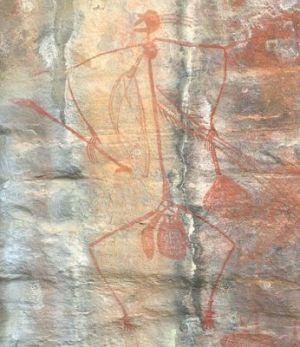Prehistoric Australian Aboriginal populations were growing
Myles Gough
Source - http://www.cosmosmagazine.com/news/4305/prehistoric-aboriginal-populations-australia-were-growing

Photo of an ochre cave painting of a hunter (or warrior) in Kakadu National Park, Northern Australia. -Credit: Wikimedia
Despite the problem of lost archaeological evidence, a new study suggests Australia’s Aboriginal populations experienced accelerated growth in the 5,000-year period before European settlement.
This research, published in Proceedings of the Royal Society B, could help resolve a debate in Australian archaeology circles about the nature of prehistoric Aboriginal population trends and shed light into how land management techniques changed the continent’s environmental history.
“A lot of Australians have a view of aboriginal history as something that was changeless for thousands of years,” said Christopher Johnson, a wildlife ecologist from the University of Tasmania and lead author of the study. “Our results imply that aboriginal societies and cultures were dynamic and changing before the arrival of Europeans.”
Resource extraction integral to growth?
Johnson said rough estimates indicate there were about one million Aboriginal people across Australia at the time of European settlement, with maybe a quarter of that number 10,000 years earlier. "This growth wasn't fast … but when you look at it over thousands of years you start to see big changes."
The reason behind this population growth is not fully understood. One fallback assumption is that the environment might have been improving, making the land more suitable for habitation and growth. But Johnson said this is unlikely.
“If anything the climate was becoming more harsh. There were more droughts, less rainfall, and it would have been less productive as far as humans are concerned,” he said.
“If the population was growing the cause must have been intrinsic to what the people were doing – reorganising their societies and some of the systems they used for land management and extracting resources from the land.”
Lost evidence hinders reconstruction
Archaeologists commonly use radiocarbon dating of evidence from occupation sites to reconstruct prehistoric population trends, which assumes that the size of a population is indicated by the amount of evidence left behind.
However lost evidence from older sites means more recent events are over-represented, which can give the appearance of population growth. This has led to uncertainty about the nature of prehistoric Aboriginal population trends.
In order to quantify this bias Johnson and his colleague Barry Brook, an environmental scientist at the University of Adelaide, compiled existing archaeological data to estimate how frequently groups of people abandoned settlement sites and how quickly evidence from these sites then disappeared. They created a model to show that this can create apparent increases in site occupation through time.
After running this through various simulations, they determined that this was not the cause of observed increases in settlement in Australia. Johnson said this observed increase is more appropriately explained by population growth, which was slow in the initial stages of the Holocene period – the last 10,000 years of Earth’s history – but accelerated in its latter half.